|
PLACE TO VISIT |
|
|
| ELLORA CAVES |
The world-heritage listed cave temple of Ellora, about 30km
from Aurangabad, are the culmination of Deccan rock-cut
architecture. There are 34 caves cut out of the sloping side
of the low hill. Another 28 caves have been discovered later
by the archeological Survey of India.
The masterpiece of Ellora is the Kailash Temple. It is the world's largest
monolithic sculpture, sculpted out of a rock by 7000
labourers over a 150 year period.
The shrines are not
exclusively Buddhist, but of Hindu and Jain faiths as well.
Entry to Ellora is free. |
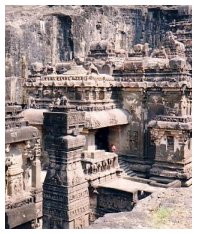 |
 |
|
AJANTA CAVES |
|
106km from Aurangabad. The 30 rock-cut Buddhist caves at
Ajanta are of two basic designs called 'Chaitya grihas' and
'Viharas'. Five of the caves are Chaityas (Buddhist
cathedrals) while the other 25 are Viharas (monasteries).
Chaitya grihas were halls of worship - large, rectangular
chambers separated by rows of pillars into a central nave,
surrounded by aisles on three sides, for circumambulation
during prayer, with a sanctuary opposite the entrance. The
Chaityas are decorated with sculptures and murals depicting
the many incarnations of Buddha. Viharas or monasteries are
rectangular shaped halls with series of small cells attached
on two sides. The side opposite the entrance contained an
image of Buddha or a votive stupa.
|
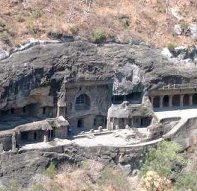 |
|
The Ajanta caves include the epic in visual form, recalling
the life of the Buddha and illustrating tales from Jatakas
(Buddhist fables). Cave 1 has a most popular painting of
Bodhisattva Avalokitesvara and Bodhisattva Padmapani (one
with the lotus in his hand). Cave 2 is remarkable for its
ceiling decorations and murals narrating the birth of
Buddha. Cave 4 is the largest vihara in Ajanta and depicts a
man and woman fleeing from a mad elephant and a man giving
up his resistance to a tempting woman.
Cave 16 has 'the Dying Princess' painting, representing the
Sundari, the wife of the Buddha's half brother, Nanda, who
left her to become a monk. A number of unfinished caves were
abandoned mysteriously. |
 |
|
AURANGABAD CAVES |
|
Lies 3 km north of Aurangabad. They were excavated out of a
south facing hill side overlooking the town. These caves fall into two groups
about 1.5km apart. These are 10 caves belong to the Buddhist era and were
excavated between 3rd and 11th century. Caves 3, 6 and 7 are specially worth
visiting. The Western group of caves comprises caves 1 to 5 and the eastern
group has caves 6 to 10. Cave 2 has a shrine and columned hallways, with a large
Buddha as Teacher in a seated position on a panel. In cave 3, there are superb
carvings on the 12 pillars of the hall way, which illustrate the jataka stories.
Cave 4, a chaitya is the oldest of the lot.
|
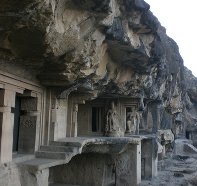 |
|
Cave 6 has a large Buddha and a supporting figure of Ganesh.
Cave 7 is regarded as the most interesting with its images
of women like Hariti and the six goddesses, including
Padmini. In the rear of the hall is a large Buddha in a
preaching position. Open from sunrise to sunset, or 1800
hours, whichever is earlier. |
 |
|
DAULATABAD FORT |
|
13 Km between Aurangabad and the Ellora caves is the
magnificent hilltop fortress of Daulatbad.
Rising dramatically over 600 ft above the Deccan plain is
the arresting sight of Daulatabad.
The fort built by
Bhilam Raja of the Yadava dynasty in 1187 was earlier called
Deogir,
served as the head quarters of the powerful Yadava rulers.
In the 13th century, Mohammed bin Tughlak, the Sultan
of Delhi, made it his capital and renamed it Daulatabad, or City of Fortune.
This fort is considered as one of the oldest existing and
impregnable forts of India. One of its attractions is the tower, Chand Minar.
|
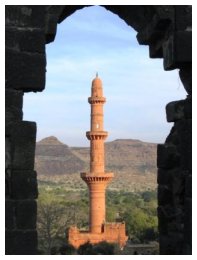 |
 |
|
BIBI-KA-MAQBARA |
|
Built by Azam Shah in 1678, the Bibi-ka-Maqbara is a son's
loving tribute to his mother, Begum Rabia Durrani, the Queen
of Mughal emperor Aurangzeb. Standing spectacularly on the
lawns of the landscaped garden with ponds, fountains and
water channels, the white marbled monument rises
majestically in an intentional bid to copy and rival the
world famous Taj Mahal of Agra.
The central tomb, distinguished by elaborate surface
ornamentation and intricately perforated marble screens, is
framed by four towering minarets. The mausoleum is far less ornamental, than Taj
Mahal. The mausoleum stands in a square of 1,37,00 sq.
meters. The monument is an excellent example of Persian
Architecture. It's more attractive at night, when it's
floodlit. It's open from sunrise to 10pm.
|
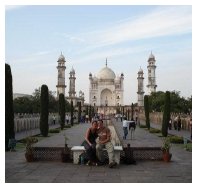 |
 |
|
PANCHAKKI |
|
It is an impressive pre-Mughal watermill harnessed to
operate large grain-grinding stones. It was
built by Malik Ambar in 1695
to
commemorate the memory of the Sufi saint Baba Shah Musafir,
whose tomb lies nearby.
|
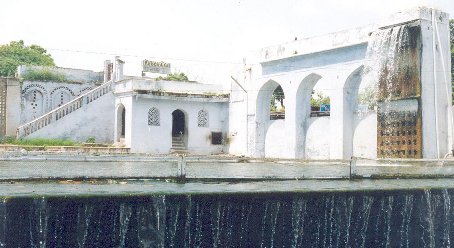 |
|
Panchakki takes its name from the
mill which was considered a marvel of engineering at that
time.
The water, channeled from a spring on a distant hill was
used to power the flour mill and grind grain for the
pilgrims. |
 |
|
HISTORY MUSEUM OF DR. BABASAHEB AMBEDKAR MARATHWADA UNIVERITY |
|
Excavated material of Sathavahana dynasty. Sculpture from
Marathwad region. Miniature paintings of Maratha, Rajput,
Mughal and company paintings of East India Company periods.
Decorative objects of Chinese and Japanese origin, China
clay and gold embroidery etc, several manuscripts of 17th
and 18th century AD in Persian and Arabic languages. Timings
: 1030 to 1730. Closed on Sundays.
|
 |
|
STATE ARCHAEOLOGY MUSEUM, SONEHRI MAHAL |
|
Sculpture and broken panels from archaeological sites in
Paithan. Timings: 1030 hrs to 1730hrs. Closed on Sundays.
|
 |
|
KHULTABAD |
|
A walled town just 3km from Ellora. It is the holy shrine of
Deccan Muslims. The austere tomb of Emperor Aurangazeb is
situated here. There is also a Mughal garden nearby, called
Bani Begum Ka Bagh. |
 |
|
GHRISHNESHWAR TEMPLE |
|
30 km from Aurangabad,
Just half a kilometre from the Ellora Caves is Ghrishneshwar
Temple. It enshrines one of the 12 jyotirlingas dedicated to
Shiva
and sacred to Hindus.
The temple walls are richly sculptured. Both the temple and
its masonry tank were built by Queen Ahilyabai Holkar, who
ruled Indore from 1765 to 1795.
A fair is held here around March each year on Mahashivaratri
day.
|
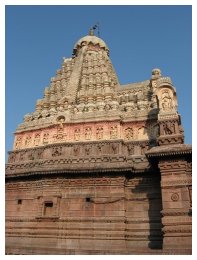 |
 |
|
PAITHAN |
|
56km (South of Aurangabad). The ancient city of Pratishthan,
now known as Paithan, was the seat of the Satvahana dynasty
who ruled from 2nd century BC to 2nd century AD. Situated on
the banks of the sacred river Godavari, the little town is
famous for its Shrine of 'Sant Eknath' which lends it
special spiritual ambience. Every year on Nath Shastri which
usually falls in the month of March, a big fair is held
called 'Paithan Yatra' which last about 10 days. People from
far and near come to pay their homage to Sant Eknath.
|
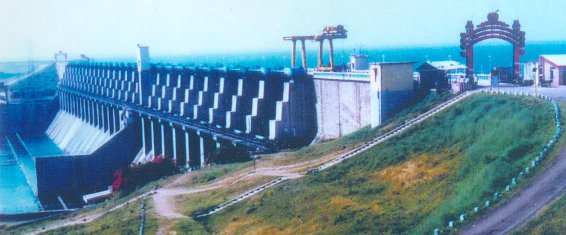 |
|
Paithan, which was once an important seat of learning, is
also famous for its beautiful silk saris which sport
intricately embroidered gold or silver borders called
'Paithani'. |
 |
|
SHIRDI |
|
130 km. from Aurangabad. Shrine of Sri Sai Baba of Shirdi. A place of
pilgrimage for devotees of Sri Sai Baba. There is a special
pooja ceremony on every Thursday.
The Shirdi Saibaba Temple, located at Shirdi, Maharashtra, India attracts
millions of devotees of all religions, castes and creed who come to pay homage
to Shri Sai Baba. The temple is a beautiful shrine that was built over the
Samadhi of Shri Sai Baba. Shirdi is a small village in Kopargam taluk, in
Ahmadnagar District of the Maharastra State. When Baba was physically present at
the age of 20 in Shirdi, it was a small village of 80 thatched houses with mud
walls. Today it is a big town with palatial modern buildings and shops. Thursday
is the day Saibaba is specially worshipped. On this day devotees from all over
India visit Shirdi for Darshan of Saibaba. The Temple opens for devotees at 5.15
a.m. (0515
hrs) with Kakad Aarti and remains open till the end of
Shejarti.
|
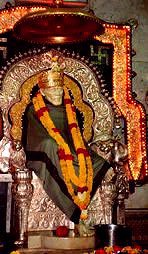 |
|
For devotees across the globe, there are arrangements to get
Pujas conducted on their behalf and the prasad sent to them.
Shirdi is well connected by road. There are also a few
religious places of tourist interest in and around Shirdi.
Shirdi Saibaba Temple is managed by Shri Sai Baba Sansthan
since 1922. The trust ensures that a strict code of conduct
is maintained in the temple premises.
* - Gargoti - A Mineral Museum...
|
 |
|
PITALKHORA CAVES |
|
Thirteen
Buddhist excavations, dating from the 2nd century BC to the
1st century AD lie about 40 km northwest of Ellora, cut into
the side of the a secluded ravine. Comprising mainly
viharas, they form the largest group of Hinayana Buddhist
structures.
Pitalkhora is best accessed by private car or taxi and can
be reached from Aurangabad by motoring on the MSH1 and
taking the diversion after Satkunda. |
 |
|
LONAR CRATER |
|
 |
|
170 kms
from Aurangabad, is the village of Lonar. Over 30,000 years
ago, a falling meteorite struck the area creating the
world's largest impact creater in basaltic rock. Botanists
have recently discovered vegetation life forms not found
anywhere else on this planet, in the stunning lake of the
crater.
|
 |
|
ANWA TEMPLE |
|
A Shiva temple, with beautifully carved sculptures and
decorated pillars stands in the village of Anwa, 10 kms east
of Golegaon, on the main road leading from Aurangabad to the
Ajanta Caves. It was built in the 12th century, and consists
of a sanctuary, a mandapa or open hall with decorated
pillars. The niches have exquisitely sculpted images of
Vishnu, Ganesha and other divinities.
Getting there: Close by to Ajanta, Anwa Temple can be
reached by taking a well-marked diversion at Golegaon.
Private car or taxi is probably the best mode of transport. |
 |
|
PARALI VAIJANATH |
|
If one is
to draw a line between Kanyakumari and Ujjain, Parali
village can be clearly seen on that line. This village is
located on the slopes of Meru or Naganarayana Mountain.
Parali is an ancient village located near three rivers,
Brahma, Venu and Saraswati, because of the presence of one
of the twelve JyotirLingas of Shankara, it has become
famous. This village is also known as Kantipur, Madhyarekha
Vaijayanti or Jayanti. It is 26 kilometers from Ambejogai in
the Beed district. |
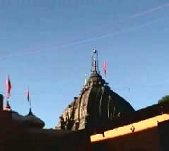 |
|
Yogeshwari of Ambejogai was
married to Lord Vaidyanatha of Parali. But by the time the
marriage party reached, the auspicious time of the wedding
had passed. As a result the people of the marriage party
turned into stone statues. Yogeshwari was waiting away from
Parali. This is one story that is frequently heard there.
When the Gods and Demons made their combined effort in Amrit
Manthan (Churning for Nectar), fourteen gems emerged. There
were Dhanwantari and Amrit Ratnas in it. When the Demons
rushed to grab Amrit, Lord Vishnu hid the Amrit and
Dhanwantari in the Shiva Linga of Lord Shankara. Just as the
Demons tried to touch the Linga, flames started emanating
from the Linga. The scared Demons ran aay. But when devotees
of Lord Shankara touched the Linga, there was a free flow of
Amrit from the same. Even today, devotees touch the Shiva
Linga as a part of taking Darshan. Here, there is no
discrimination between caste, creed or color. Anyone can
come and visit this place. As the Lingamurthy is supposed to
have Amrit and Dhanvantari, it is also known as Amriteshwar
and Dhanvantari. |
 |
|
AUNDHA NAGNATH |
|
The twelve
jyotirlingas are the most significant places of pilgrimage
for Hindus in India. Five of them happen to be in
Maharashtra. Shiva has been worshipped in these places for
centuries. Aundha-Nagnath is one of them. Anudha Nagnath is
in the Hingoli District.
This pilgrim center is of great significance, since it is
considered to be the Eighth (adya), of the 12 jyotirlingas.
It is believed that Dharmraj (eldest of Pandav) has
constructed this beautiful temple while they were expelled
for 14 years from Hastinapur. |
|
|
|
The temple of Nagnath has exquisite carvings. The temple is
of Hemadpanthi architecture and is situated in about 60,000
sq. ft area. Large number of pilgrims visit this temple on
shivratri and Vijayadashmi. |
 |
|
TAKHAT SACHKHAND SHRI HAZUR
ABCHALNAGAR SAHIB GURUDWARA |
|
Takhat
Sachkhand Shri Hazur Abchalnagar Sahib is the main Gurudwara
of Nanded and is one of the four High seats of Authority of
the sikhs. This is the place where Shri GuruGobind Singhji
breathed his last. The Gurudwara is situated in Nanded Town.
The Gurudwara was built by Maharaja Ranjit Singhji, The
great Ruler of Punjab between 1830 to 1839 A.D. Inside the
Gurudwara, which contains the mortal remains of the 10th
Guru, there are exhibited a number of weapons of various
kinds. |
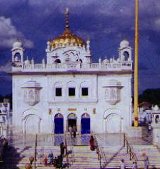 |
 |
|
TANK MUSEUM |
|
Museum
buffs in India might have heard of technological museums and
Railway museums but only a few might have heard of the
Cavalry Tank Museum of the Armoured Corps Centre and School,
Ahmednagar, the first of its kind in Asia. The museum has a
rich collection of tanks used during different periods.
Indeed, what the ship is to the Navy and the airplane is to
the Air Force, tank is to the Army. Former Army Chief (late)
Gen BC Joshi-a tankman himself-inaugurated this museum in
1994. |
|
The earliest tanks-the British Mark I were used during World
War I. Nicknamed Big Willie and fitted with a tractor
engine, Mark-I was an effective weapon in battle because it
could cross trenches and literally take the battle into the
enemy camp.
The museum traces the
evolution of the modern-day tank using an assortment of
displays like armoured cars, reconnaissance vehicles and
light tanks. It has a model
|
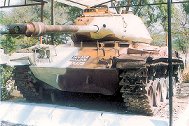 |
|
belonging to the
class of armoured cars that General Dwyer used to enter
Amritsar’s Jallianwala Bagh. The 1934 armoured car Schmerer
Panzersphah Wagen (8-RAD) donning a 'swastik’, a vital
component of Adolf Hitler's fleet, transports the visitors
to the Nazi era of Europe. Many of the tanks on display at
the museum were originally German and Japanese tanks
captured during World War II. Pakistani tanks like Chaffee,
Walker-Bulldog and Patton that took part in 1965 and 1971
are were also on display here. The rest of the 40 tanks are
vehicles that served the Indian Army’s Armoured Corps right
from its earliest years. All stand as a mute testimony to
the glorious tradition of the mechanised armour since World
War I. |
 |
|
JAMA MASJID |
|
The Jama
Masjid at Aurangabad was built by Aurangzeb. It situated in
the center of a grove of trees in Killa Arrack. The Masjid
has a low building with minarets and a broad band. This
broad band is carved with Koranic inscriptions written
through the length of the facade. |
 |
|
GARGOTI - THE MINERAL
MUSEUM |
|
Around 30
Mins by road from Nashik Road railway station. There is one
wonderful museum Gargoti - the mineral museum. It contains
different types of minerals found in & outside India.
Speciallity of this museum is that each mineral displayed is
different from the other. Regular ST buses run from the
adjacent ST depot to Sinnar Town. Some buses halt at the
Industrial Area while other will drop you at Sinnar Town
from where you can take a rikshaw for around Rs. 75 - RS.
100. It falls on the Nashik - Shirdi highway. |
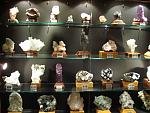 |
Charge : Rs. 100 Per
Person. (Includes Guide fees)
Timings : 10.00 -22.00 Hrs (for other timings pre
appointments required )
Last Admission : 18.00 Hrs
Working Days : 24 hrs
weekly off or holidays : No
Website:
http://www.superbminerals.com/mineral-museums.asp
Contact No: +91-253-2415237
E-mail: info@superbminerals.com
|
 |
| AHMEDNAGAR FORT |
|
The third
Nizam Shah, Hussain, who ascended the throne in 1553 AD,
found himself constantly at war with his neighbours. Six
years after his ascension, he was besieged by Ram Raja, the
king of Vijaynagar. He decided to strengthen the mud edifice
created by his grandfather, which he had been using as a
fort.
A team of Portuguese engineers was commissioned, and they
created what is seen of the Ahmednagar fort today. |
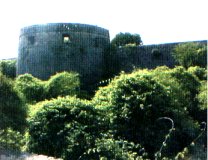 |
|
Over a mile in circumference,
it was built from rock hewn out of the moat, almost 200 feet
wide and twenty feet deep. The duke of Wellington, who
captured the fort in 1803, considered it one of the
strongest forts he had ever seen.
In 1942 Pandit Nehru and other Indian leaders were
incarcerated within the walls of the fort. Pandit Nehru
wrote famous book ‘Discovery of India’ during this period.
|
 |
| |

